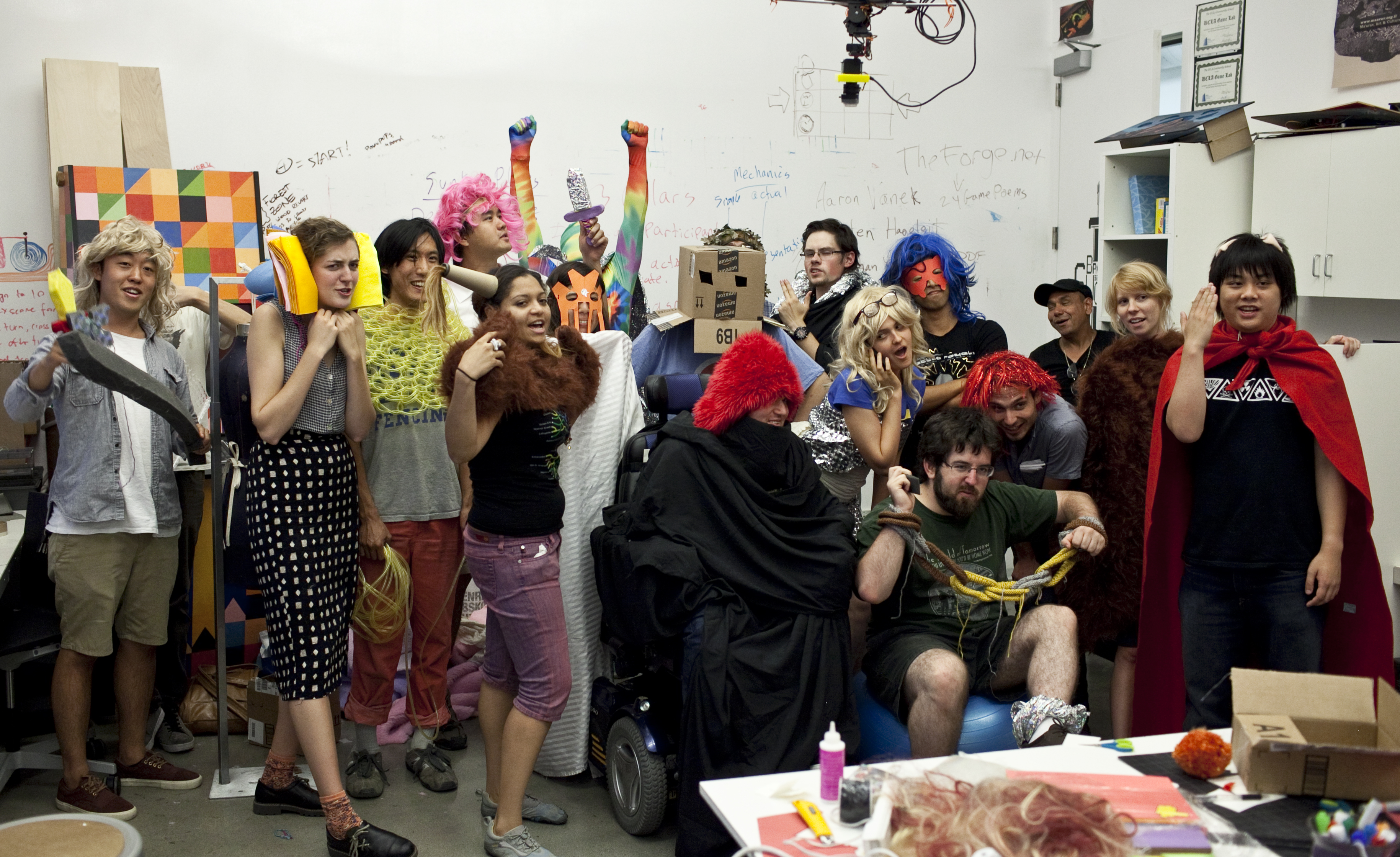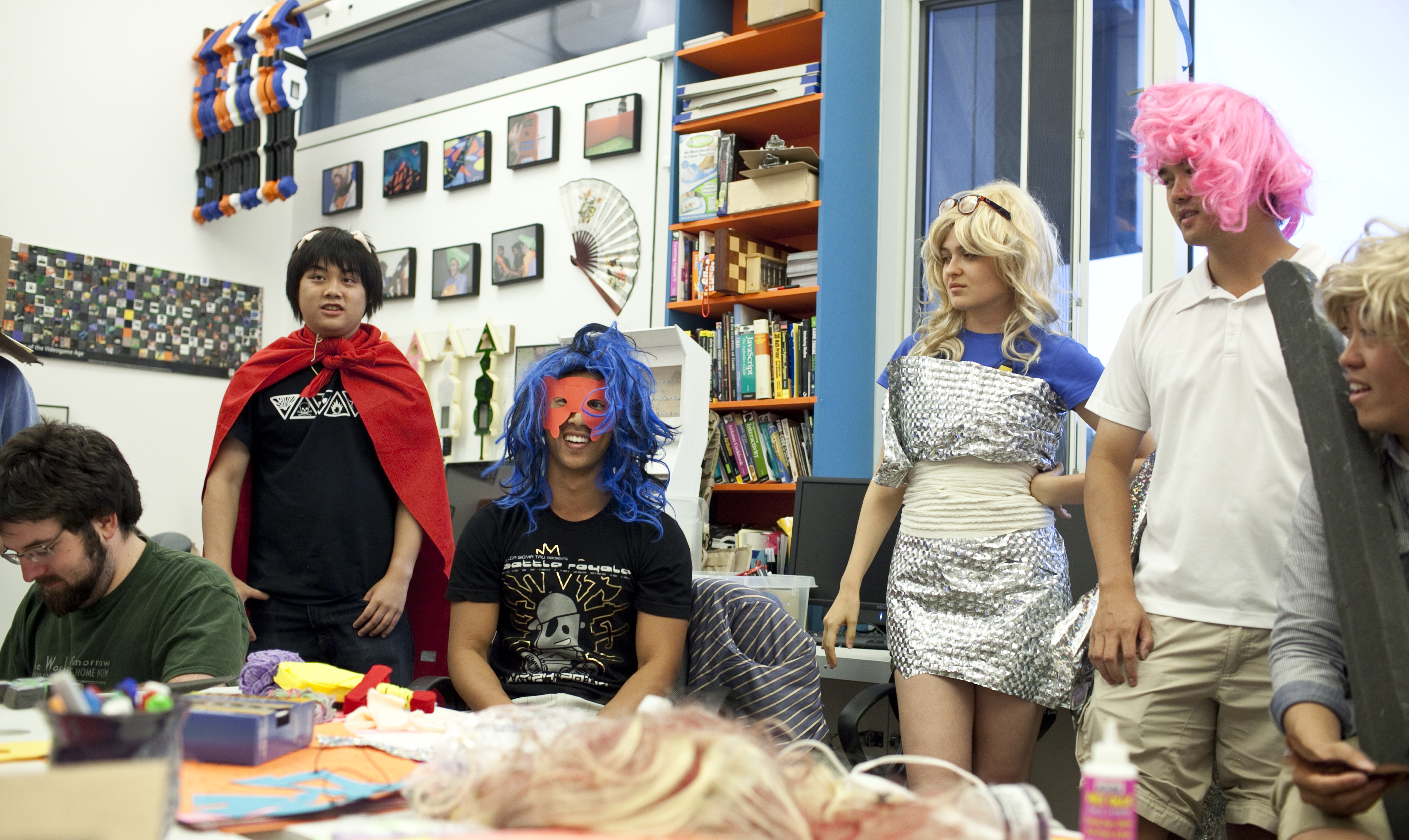
In an event put on by the UCLA Game Lab on Tuesday at the Broad Art Center, participants worked in collaboration to design a live-action role-playing game. This game, which entailed the quick invention of unique and imaginative characters, will be featured at the Melrose Trading Post in October.
Moustachia, Mistress of the Night, is a sultry individual who isn’t afraid to leave a little extra hair under her arms, or anywhere else for that matter. Her complete upper torso sports a mane-like, classic stache that extends beyond her shoulders. But underneath that coat of whiskers is a closely kept secret: hair plugs.
Fabricated in just more than 10 minutes Tuesday evening, Moustachia is one of the many inspired characters created in anticipation of the UCLA Game Lab’s first live-action role-playing event.
As the center for gaming creation and experimentation on campus, the Game Lab volunteered to create and perform a live-action role-playing game, every Sunday in October, claiming the flea market stalls and avenues of the Melrose Trading Post as their playground.
“It’s not hardcore. You don’t have to have some great skill. You can be shy, you can be embarrassed, you can break character. For some LARPers it’s super serious, but with us, you can put something silly on your head and just start giggling,” said Aliah Magdalena Darke, a fourth-year Design | Media Arts student, the event’s project manager and Moustachia herself.
The live-action role-playing event tasks performers with designing and interacting as characters from either a fictional or factual world. Some live-action role-playing games last for a few hours, where others can last for as long as 30 days.
“It’s play pretend acting. … From playing cowboys and Indians to having a tea party, …(live-action role-playing) is the exact same thing children do intuitively (and) instinctually, except it’s being done on a more elaborate scale,” said Game Lab manager David Elliott.
Held in the Game Lab itself, this precursor to Sunday’s actual event challenged Darke, Elliott and the 15 or so students and Game Lab members who joined them to invent specific characters complete with names, backgrounds, costumes and personalities in a few short minutes.
To help with the time crunch as well as the anxiety of having to embody the character once it was completed, participants were asked to write an adjective on a piece of paper and place it within a box. The box was then passed around as participants randomly picked out the adjective that would describe their character.
This spawned names such as Shady Shades, Sexy Steve and Porsche Chrysanthemum In the Sky with Diamonds, a disillusioned Barbie whose unusually long name matched her even larger ego.
The costumes were even more elaborate, combining bits of multicolored fabric, foam, cellophane and yarn found around the Game Lab. Performers suddenly transformed into wacky characters once the whole ensemble was complete, but the person beneath the disguise was still apparent.
“You can only play your character between 1 and 99 percent. … You’re at least 1 percent when you engage in the rules of the game and you can never be more than 99 percent because there’s always your real ego or your real self in there somewhere,” Elliott said. “And at the point when you reach 100 percent, you’re not really playing a LARP anymore, you’ve just hit some kind of schizophrenia.”
LARPs also tend to have a specific quest, end goal or set of rules. To give their live-action role-playing some story structure, the Game Lab drew from historical ’60s radical activist groups like the Diggers and Weather Underground, and incorporated some superficial similarities.
For one, the Game Lab’s live-action role-playing characters are also part of a radical activist group that plans to swap real currency with pom-poms”“ little handcrafted balls made from scraps of fabric. They intend to set up at the Melrose Trading Post and eventually make pom-poms a viable currency by trading them for actual items ““ all the while staying in character.
There will also be a hint of paranoia at having possibly been infiltrated by the Central Intelligence Agency, as was the case with the ’60s groups. After being introduced to this initial story idea, participants were invited to expand on the concept.
Darke said this simple structure helps to move the development and creative processes along, but without impeding new ideas.
“You want to give people the right level of freedom. If you just give them nothing to go on, it’s chaos, and then … that’s almost too much work for them,” Darke said. “But then if there’s too much restriction, you don’t get the fun, spontaneous moustache costume that comes out of that wildness.”
For fourth-year Design | Media Arts and English student, Deanna Hjerling, it was this sense of discovery that made her change her original preconceived notions about live-action role-playing and who commonly practices them.
“At first I was like, this is such a nerd thing. (But) when I finally learned … what LARPing actually was, I was so down. I love the idea of being able to create your own world and explore it, and solve its mysteries in a sense,” said Hjerling, who designed a pair of yarn spool binoculars for Mysterion, her silent character gifted with foresight.
While Hjerling’s initial impression of live-action role-playing is a common reaction, Elliott said it shouldn’t phase those who enjoy the art of it.
“I’m sure (that) whatever stigma may be conceived about LARPing has absolutely no effect on the people who actually care about LARPing,” Elliott said. “I mean they’re already experts in playing make-believe, so if they don’t like something, they can just pretend that it doesn’t exist.”
